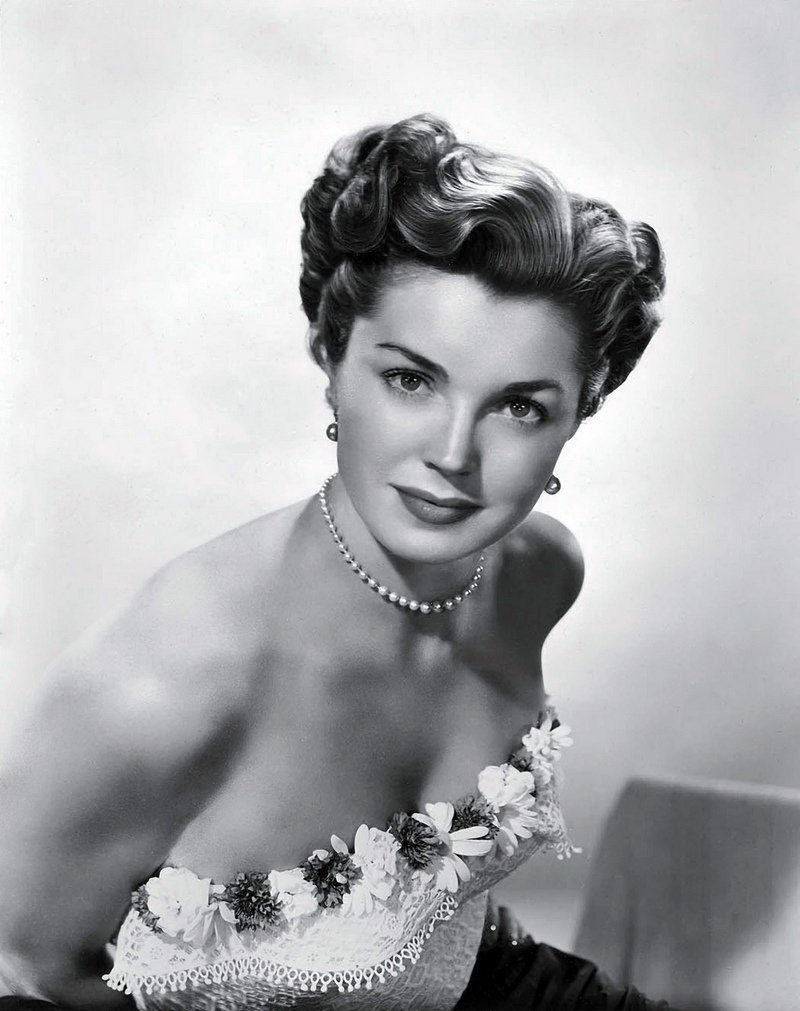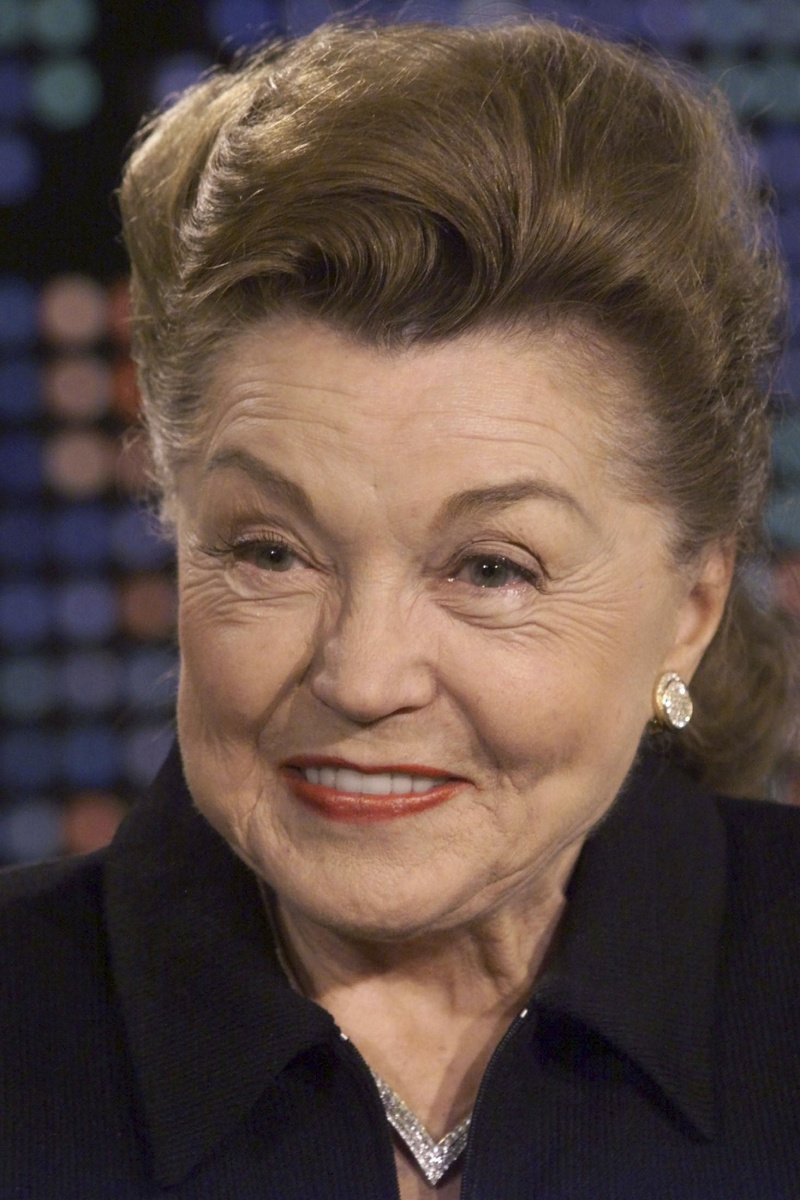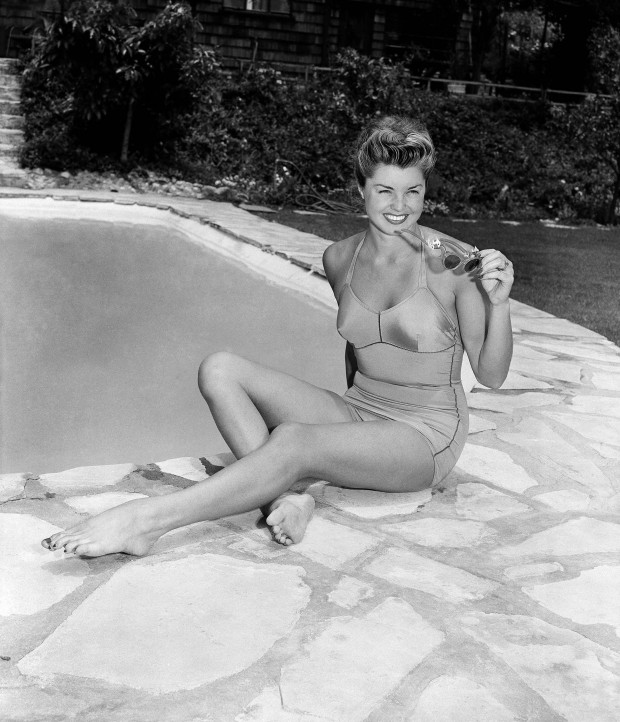Esther Williams (Esther Jane Williams)

Esther Williams
Born in Inglewood, California, on August 8, 1921, Williams was the fifth and youngest child of Louis Stanton Williams (January 19, 1886 – June 10, 1968) and Bula Myrtle (née Gilpin; October 8, 1885 – December 29, 1971). Louis Williams was a sign painter and Bula Myrtle Williams was a psychologist. The two lived on neighboring farms in Kansas and carried on a nine-year courtship until June 1, 1908, when they eloped and set off for California. However, they ran out of money in Salt Lake City, Utah, and settled there. Esther’s brother, Stanton (September 4, 1912 – March 3, 1929) was discovered by actress Marjorie Rambeau, which led to the family (including sisters Maurine and June and brother David) moving to the Los Angeles area to be near the studios. Louis Williams purchased a small piece of land in the southwest area of town, and had a small house built there. Esther was born in the living room, which was also where the family slept, until Louis Williams was able to add bedrooms. In 1929, Stanton Williams died after his colon burst.
In 1935, Bula Myrtle Williams invited 16-year-old Buddy McClure to live with her family. McClure had recently lost his mother and Bula was still grieving over the death of her son. Esther recounted in her autobiography that one night, when the rest of the family was visiting relatives in Alhambra, McClure raped her. She was terrified to tell anyone about the incident and waited two years before finally revealing the truth to her parents. Williams’ mother seemed unsure about her story, claiming McClure was “sensitive” and were sympathetic towards him when he admitted his guilt. Bula Williams then banished him from her home, McClure joined the Coast Guard, and Williams never saw him again.
Williams was enthusiastic about swimming in her youth. Her older sister, Maurine, took her to Manhattan Beach and to the local pool. She took a job counting towels at the pool to pay the five cent entry fee, and while there, had swimming lessons from the male lifeguards. From them, she learned the ‘male only’ swimming strokes, including the butterfly, with which she would later break records. Her medley team set the record for the 300-yard relay at the Los Angeles Athletic Club in 1939, and was also National AAU champion in the 100 meter freestyle, with a record-breaking time of 1 minute 09.0 seconds. By age 16, Williams had won three US national championships in breaststroke and freestyle swimming.
Williams graduated from Washington High School (now known as Washington Preparatory High School) in Los Angeles, 1939, where she served as class Vice President, and later President. However, Williams never trained in swimming while there. During her senior year of high school, Williams received a D in her algebra course, preventing her from getting a scholarship to the University of Southern California. She enrolled in Los Angeles City College to retake the course. In 1939, Williams expressed interest in pursuing a degree in physical education in order to teach it one day. To earn money for tuition, Williams worked as a stock girl at the I. Magnin department store, where she also modeled clothing for customers and appeared in newspaper advertisements.
While Williams was working at I. Magnin, she was contacted by Billy Rose’s assistant and asked to audition as a replacement for Eleanor Holm in his Aquacade show. Williams impressed Rose and she got the role. The Aquacade was part of the Golden Gate International Exposition, and Williams was partnered with Olympic swimmer and Tarzan star Johnny Weissmuller, who, Williams wrote in her autobiography, repeatedly tried to seduce her. Despite this, Williams remained with the show until it closed on September 29, 1940. Williams had planned to compete in the 1940 Summer Olympics but it was cancelled because of the outbreak of World War II.
It was at Aquacade that Williams first attracted attention from Metro-Goldwyn-Mayer scouts. MGM’s head, Louis B. Mayer, had been looking for a female sports star for the studio to compete with Fox’s figure skating star, Sonja Henie. Williams signed her contract with MGM in 1941. In her contract were two clauses: the first being that she receive a guest pass to The Beverly Hills Hotel where she could swim in the pool every day, and the second that she would not appear on camera for nine months to allow for acting, singing, dancing, and diction lessons. Williams wrote in her autobiography, “If it took nine months for a baby to be born, I figured my ‘birth’ from Esther Williams the swimmer to Esther Williams the movie actress would not be much different.”
While top stars at the studios such as Judy Garland, Betty Grable, and Shirley Temple took part in bond tours during the war, Williams was asked to take in hospital tours. At this point, Williams had achieved pin-up status because of the number of photographs of her in bathing suits. To prepare, Williams and her publicity assistant would listen to Bob Hope and Jack Benny’s radio programs, retelling the funniest jokes while at the hospitals. Williams also invited GIs to dance with her on stage and take part in mock screen tests. The men would receive a card telling them their lines, and they would act out the scene in front of the other soldiers. These tests were always romantic scenes and included Williams begging the men to have sex with her character, to which they were required to refuse … multiple times. When the men said the final, “No,” Williams would pull at her tear-away skirt and sweater leaving nothing but a gold lamé swimsuit. The scenes would always end with the men giving in and kissing her after that stunt. Her hospital tours continued into the 1950s. A (forged) signed, waterproof portrait of Williams was circulated among men in the United States Navy for a “capture the Esther” competition. This competition continues to this day in the Royal Australian Navy, which holds in its archives an “original” forged signed portrait while maintaining a “capturable” image for use in the fleet.
Williams made Duchess of Idaho (1950), shot on location in Sun Valley, Idaho, co-starring Van Johnson.[48] MGM paired her with Howard Keel for two films, Pagan Love Song (also 1950) and later Jupiter’s Darling (1955). They both had cameos in the film Callaway Went Thataway (1951). In Million Dollar Mermaid (1952), Williams portrayed Annette Kellerman, a real-life Australian swimming and diving star. Williams co-starred with Victor Mature, who played Kellerman’s husband and manager, James Sullivan. The two engaged in a passionate affair during filming. Williams often called this her favorite film, and named her autobiography after it. Williams also won the Henrietta Award at the 1952 Golden Globes, for World Film Favorite – Female. Easy to Love (1953), also with Van Johnson, was filmed on location in Cypress Gardens, where a swimming pool in the shape of the state of Florida had been built specifically for the film. Williams was pregnant during shooting, but still performed all her own waterskiing stunts. In Dangerous When Wet (also 1953), Williams worked with three important males – Tom and Jerry and future husband Fernando Lamas. During casting, Lamas told Williams he did not want to star in the film with her because he only wanted to be involved in “important pictures”. His part had to be rewritten to persuade him to take part in the film.
In 1953, Williams had been on maternity leave for three months while pregnant with daughter Susan, and assumed she would go straight to work on the film Athena when she returned. However, production started without her, and the studio cast Jane Powell in the lead role, rewriting much of the premise that Williams and writers Leo Pogostin and Chuck Walters had come up with. The studio moved her to Jupiter’s Darling. Two more films were planned, Bermuda Encounter and Olympic Venus, about the first Olympic swimmers; however, these were never made.
Many of her MGM films, such as Million Dollar Mermaid and Jupiter’s Darling, contained elaborately staged synchronized swimming scenes, with considerable risk to Williams. She broke her neck filming a 115 ft dive off a tower during a climactic musical number for the film Million Dollar Mermaid and was in a body cast for seven months. She subsequently recovered, although she continued to suffer headaches as a result of the accident. Her many hours spent submerged in a studio tank resulted in ruptured eardrums numerous times. She also nearly drowned after not being able to find the trap door in the ceiling of a tank. The walls and ceiling were painted black and the trap door blended in. Williams was pulled out only because a member of the crew realized the door was not opening.
After 15 years of appearing in films, Williams was threatened with contract suspension from MGM after refusing the lead role in The Opposite Sex (eventually released in 1956), a musical remake of 1939’s The Women. The role of Mary would have been rewritten to be an aquacade star (and was eventually filled by June Allyson as “Kay”, a nightclub singer). Williams redecorated her dressing room to accommodate returning star Grace Kelly, packed her terry cloth robes and swimsuits and drove off the studio lot. As a result of leaving her contract, Williams lost almost $3 million in deferred contract payments, which had been taken from her paychecks over the previous 14 years and put aside as both a nest egg and a tax deferral. She was, however, still able to collect on the $50,000 signing bonus from when she first signed her contract.
In 1956, she moved to Universal International and appeared in a non-musical dramatic film, The Unguarded Moment (1956). After that, her film career slowly wound down. She later admitted that husband Fernando Lamas preferred her not to continue in films. She would, however, make occasional appearances on television, including mystery guest appearances for What’s My Line?, The Donna Reed Show, The Ed Sullivan Show, and two aqua-specials, The Esther Williams Aqua Spectacle (1956) and Esther Williams at Cypress Gardens which was telecast on August 8, 1960. More than half of all television sets in use in the United States were tuned in to watch the Cypress Gardens special.[60] She starred in an aqua-special at Wembley Stadium in London. In 1966, Williams was inducted into the International Swimming Hall of Fame.
Williams retired from acting in the early 1960s and later turned down the role of Belle Rosen, a character with a crucial swimming scene, in The Poseidon Adventure. She continued to lend her name to a line of retro women’s swimwear. “Women worldwide are fighting a thing called gravity”, said Williams. “I say to women when I talk to them, ‘You girls of 18 have until about 25, 30 at the most, and then you have to report to me. My suits are quality fabric.'” “I put you in a suit that contains you and you will swim in. I don’t want you to be in two Dixie cups and a fish line.”
She was also the namesake of a company that manufactures swimming pools and swimming pool accessories. She came out with a line of Swim, Baby, Swim videos, which helped parents teach their children how to swim. She also appeared as a commentator for synchronized swimming at the 1984 Summer Olympics. Williams met her fourth husband as a result of his calling her to coordinate her appearance. She co-wrote her autobiography The Million Dollar Mermaid (New York: Simon and Schuster, 1999) with popular media critic and author Digby Diehl. In a 2007 interview with Diane Sawyer, Williams admitted she had recently suffered a stroke. “I opened my eyes and I could see, but I couldn’t remember anything from the past”, she said. In June 2008, Williams attended Cyd Charisse’s funeral in a wheelchair.
In April 2010, Williams appeared at the first Turner Classic Movies Classic Film Festival in Hollywood, California, alongside two-time co-star Betty Garrett. Her film Neptune’s Daughter (1949) was screened at the pool of the Roosevelt Hotel, along with a performance of the Williams-inspired synchronized swimming troupe, The Waterlilies. South Beach Miami’s 2010 Mercedes Benz Fashion Week Swim, a showcase of designer swimwear, included a Williams suite, complete with a beach summer theme and sand palette with aqua accents. In 2000 an account of Williams’ life and career appeared in the Swedish book Esther Williams — Skenbiografin (i.e. “Esther Williams — The Fake Biography”) by Jane Magnusson, in which the author shares with readers her own fascination for art swimming as a genre and, here, in particular, Williams as — to the author — both a bewildering and mesmerizing front figure and icon in this field.
Williams married four times. She met her first husband Leonard Kovner while attending Los Angeles City College. She later wrote in her autobiography The Million Dollar Mermaid that “he was smart, handsome, dependable…and dull. I respected his intelligence, and his dedication to a future career in medicine. He loved me, or so he said, and even asked me to marry him.” They were married in the San Francisco suburb of Los Altos on June 27, 1940. On their split she said “I found, much to my relief, that all I needed for my emotional and personal security was my own resolve and determination. I didn’t need a marriage and a ring. I had come to realize all too quickly that Leonard Kovner was not a man I could ever really love.” They divorced on September 12, 1944.
She married singer/actor Ben Gage on November 25, 1945; they had three children, Benjamin Stanton (born August 6, 1949), Kimball Austin (October 30, 1950 – May 6, 2008) and Susan Tenney (born October 1, 1953). In her autobiography, she portrayed Gage as an alcoholic parasite who squandered $10 million of her earnings. Gage and Williams separated in 1952, and divorced in April 1959. During the filming of Pagan Love Song in Hawaii, Williams learned she was pregnant with her third child, and notified the studio in California. Gage had met a man at the hotel who owned a ham radio and persuaded the man to let them use it to call California. What they failed to realize at the time, though, was that anyone could be listening in on their conversation, and news of her pregnancy was broadcast to the entire West Coast.
She disclosed in her autobiography that she had an affair with actor Victor Mature while they were working on Million Dollar Mermaid, citing that at the time her marriage was in trouble and, feeling lonely, she turned to Mature for love and affection, and he gave her all she wanted. The affair stopped while Williams was recovering from her fall during the shooting of Million Dollar Mermaid. She was romantically linked with Jeff Chandler. She claims in her autobiography that Chandler was a cross-dresser and that she broke off the relationship. According to the Los Angeles Times, many friends and colleagues of Chandler’s rebutted Williams’ claims. Jane Russell commented, “I’ve never heard of such a thing. Cross-dressing is the last thing I would expect of Jeff. He was a sweet guy, definitely all man.”
She married her former lover, Argentine actor/director, Fernando Lamas on December 31, 1969. For 13 years, she lived in total submission to him, where she had to stop being “Esther Williams” and could not have her children live with her. In return, he would be faithful. They were married until his death from pancreatic cancer on October 8, 1982. She resided in Beverly Hills with actor husband Edward Bell, whom she married on October 24, 1994.
In September 1959, Cary Grant confessed to Look magazine that he had taken LSD under a doctor’s supervision, and it had changed his life. Grant’s therapist, Dr. Mortimer Hartman, described LSD as “a psychic energizer which empties the subconscious and intensifies emotion and memory a hundred times”. Grant said that, with the help of LSD, he had “found that [he] had a tough inner core of strength,” and that when he was young, he “was very dependent upon older men and women. Now, people [came] to [him] for help.” Williams stated that she wanted to be one of those people. As she said in Million Dollar Mermaid, “At that point, I really didn’t know who I was. Was I that glamorous femme fatale?… Was I just another broken-down divorcée whose husband left her with all the bills and three kids?” Shortly after reading the article, she contacted Grant. He called his doctor and made an appointment for her. Williams said LSD seemed like instant psychoanalysis.
Williams died in her sleep on June 6, 2013 from natural causes, in her Los Angeles home. Of her death CNN quoted her International Swimming Hall of Fame biography, saying, “Her movie career played a major role in the promotion of swimming, making it attractive to the public, contributing to the growth of the sport as a public recreation for health, exercise, water safety — and just plain fun.” Her stepson Lorenzo Lamas tweeted she was “The best swim teacher and soul mom.” Her friend Annabeth Gish also tweeted a tribute, writing that Esther Williams was “An elegant, gracious movie star, legend and neighbour”. Film historian Leonard Maltin called her “a major, major star, a tremendous box office attraction.” For her contribution to the motion-picture industry, Williams has a star on the Hollywood Walk of Fame at 1560 Vine Street. She left her hand and foot prints in front of the Grauman’s Chinese Theatre on August 1, 1944.
Born
- August, 08, 1921
- Inglewood, California
Died
- June, 06, 2013
- Los Angeles, California
Cause of Death
- natural causes
Other
- Cremated




